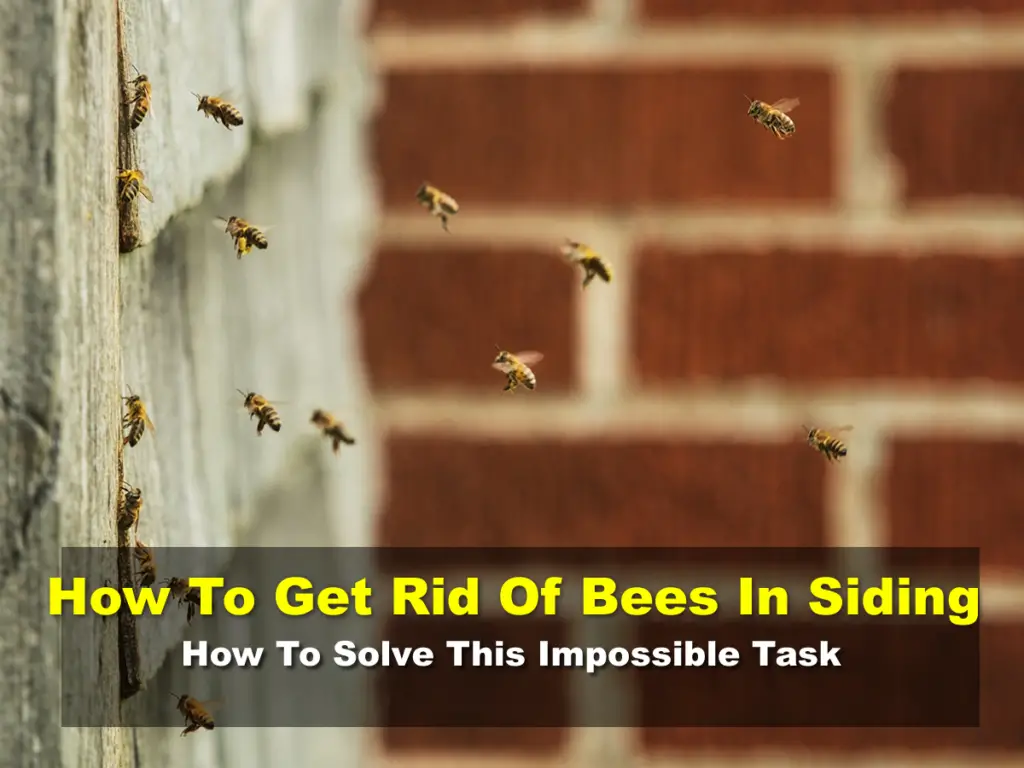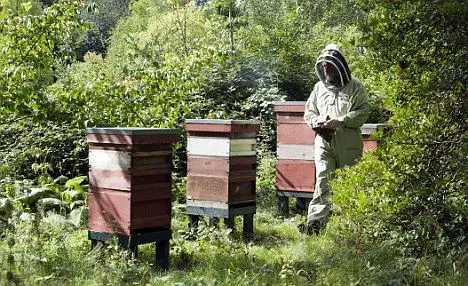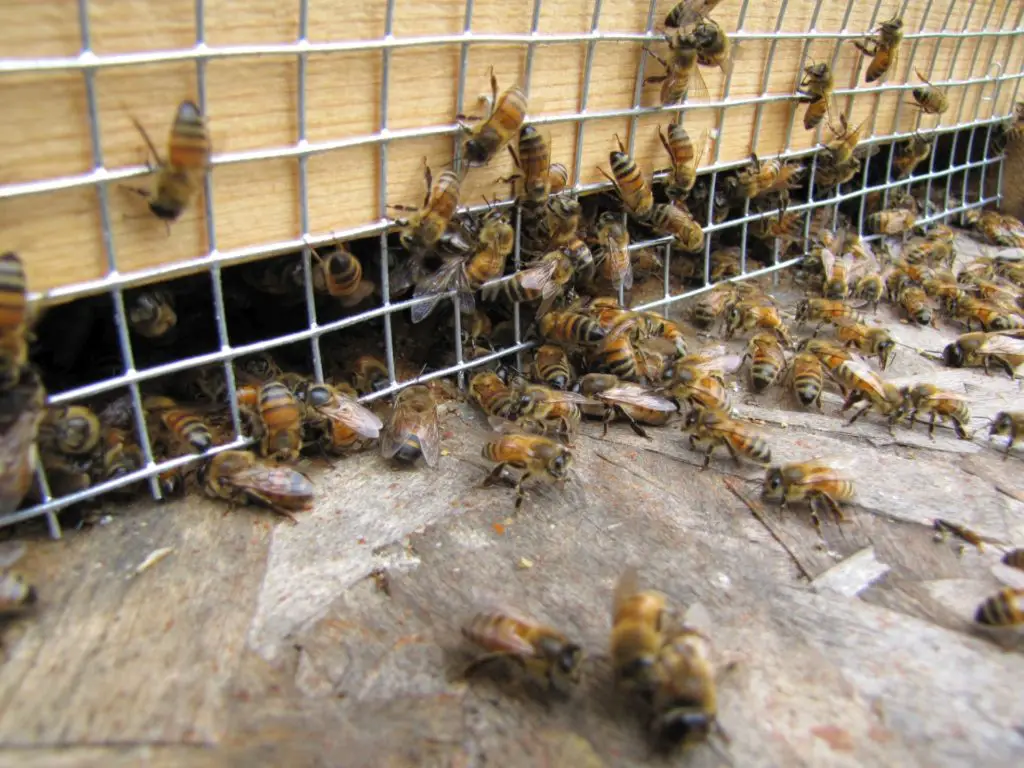Affiliate Disclaimer - As an Amazon Associate I earn from qualifying purchases.
It supports the website. So, Thank you
If you’ve noticed a bee’s nest under the siding of your house, I can understand that panic might ensue. People worry about the potential damage that the bees could cause, not to mention that not many homeowners want to share their property with stinging insects. But many people don’t know how to get rid of bees in siding.
You have to decide whether you want to naturally remove the bees or whether you’re happy to use insecticides to completely wipe them out. Once you have made this decision, there are several ways you might approach the situation.
I’ll discuss various methods in this guide both natural ones and those that involve chemicals. However, one thing I would advise before we start is that it’s incredibly important to remain safe when handling bees, especially where there are large numbers of them.
Table of Contents
What Type Of Bees Nest In House Siding?
While pretty much any kind of bee could, in theory, reside under your siding, these are usually anomalies. That’s because different types of bees like to nest in different environments. For example, bumblebees are ground nesters and so it would be very unlikely to find them hiding out in the siding.
Typically, you would expect to find carpenter bees under your siding but there’s also a chance they could be masonry bees.
In either case, there’s not too much cause for concern because neither of these bees is aggressive. Only the females have stingers and they’ll generally only use these when they feel threatened.
Of course, most people aren’t keen on sharing their backyard with bees simply because of the risk of stings and because they can be a nuisance when you’re trying to enjoy some time outdoors.
Another problem that people worry about is whether the bees will cause any structural damage to your property. If there’s a single nest which moves on (and it will do eventually), the damage will be minimal with the bees making small holes for nesting. Of course, if you have many nests over a very long period of time, the damage would be more extensive but it’s unlikely to cause any very serious problems.
What’s The Best Way To Get Rid Of Bees In Siding?
As I mentioned earlier, there are two options when it comes to getting rid of bees that are nesting under your siding. You can go for a natural approach which is beneficial for the bees as it will deter them but won’t harm them. For more severe infestations, you may choose to go down the chemical route, using insecticide products to eradicate the population. I’ll go more into the moral dilemma behind this later on. For now, let’s take a look at some viable options for bee removal.
Natural Methods
If you’re looking for a way to make your home more uncomfortable and uninhabitable for the bees then a natural approach might be the way to go. These methods will create an environment that bees just don’t like and they’ll likely leave and find somewhere else to nest.
The problem with these natural methods is that they can take some time so you’ll need to have a degree of patience while they take effect.
A great option is to use bee repelling plants around the area of the nest. This can include things like cucumber, geraniums, eucalyptus, and wormwood, among others. Just plant them as close to the nest as possible and in as great a number as possible and allow nature to work its magic.
If this isn’t having the desired effect then you could try sprinkling some cinnamon powder or garlic powder around the entrance to the nest. Bees cannot stand the smell of these kitchen staples and are unlikely to hang around while they’re present.
Both of these methods could take anywhere from a couple of days to a week to take effect so, as I’ve said, you’ll need to be patient.
If you’re looking for a natural method that’s a little quicker than a bee smoker could be a viable option. You can purchase these beekeeping tools online or at your local hardware store and they’re relatively easy to use (check out my guide here.)
You’ll need to direct the smoke under the siding but keep in mind that this option is best for vinyl siding as anything else may be damaged by the heat and/or smoke. Smoke messes with a bee’s natural pheromone communication but they also don’t like it so if they’re constantly being smoked out, they’ll find somewhere else to call home.
The great thing about smoking the bees out is that it causes no lasting harm to them and any effects will wear off within around twenty minutes. Do keep in mind that you may need to repeat the process several times before it takes full effect.
Insecticides
Without a doubt, the quickest way to deal with pesky bee infestations is to use an insecticide. These are chemical products containing ingredients which are lethal to bees and when applied, will quickly kill anything that’s inside the nest.
Insecticides are widely available but you need to make sure you’re choosing one that’s specifically designed for bees otherwise it may not be effective.
Different insecticides need to be used in different ways so it’s really important to follow the instructions carefully for maximum effect and your own safety.
If you’re using these products in a backyard where pets and children are present, be sure to keep them well out of the way. While insecticides may not be fatal to humans and pets (although they could be), they’ll certainly do some damage if inhaled or ingested; it’s just not worth the risk.
Do I Need To Remove The Siding?
Removing the siding panels can be a real pain in the backside, not to mention the labor costs if you hire a professional to do the work. This can be the stuff of nightmares for homeowners but there’s really very little reason to worry because, in most cases, you won’t need to rip the panels off to remove the bees.
In very severe cases, this may be a last port of call and will likely need to be carried out by a professional exterminator. However, rest assured that they’re trained to cause as little damage as possible and will never remove anything without your express permission.
Sealing Things Up
Once you have successfully gotten rid of your unwelcome visitors, you’ll need to check your home for potential entry sites. Now, this is tricky when it comes to siding as the panels overlap each other, leaving room for bees to set up their home.
However, you may notice small holes or cracks that provide easier access to the underside of the siding or even into the walls beneath. If this is the case, it’s essential to seal these cracks to prevent more bees from getting inside.
If your siding is warped, rotten, or otherwise damaged, this can be attractive to bees so it may be worth considering a replacement. Plus, this will ensure your home is better insulated so you’ll save on your energy bills as well.
Should I Kill The Bees?
Here is where we face a moral dilemma. Bees are living creatures and they’re very important pollinators so you’ve probably heard a lot of people saying that you should never harm them.
Personally, I would not use an insecticide unless it was a very last resort as I’m very keen to protect bees. But that doesn’t mean I’m going to judge you if you decide to use this as your primary method.
It’s all about personal choice and morals and we’re all different in this aspect. If you find yourself with a large infestation in a family yard then getting rid of the bees as quickly as possible is a must and sometimes, an insecticide is the best way to do this.
However, if you aren’t in a hurry to get rid of the bees and are able to wait a few days then using a natural method is preferable.
Precautions When Handling Bees
Most bee species are capable of stinging and they won’t do it unless they feel threatened. However, if you’re going in and trying to eradicate their home they’re not going to be very happy about this and there’s a good chance they’ll get riled up.
For this reason, it’s essential to take proper care when handling the removal of bee nests so here are my top tips for staying safe.
- Always wear appropriate clothing. If you happen to have a bee suit lying around then great but let’s be honest, most of us don’t. Long sleeves and pants with gloves and eye protection should give you enough of a barrier from being stung. Just make sure that your sleeves and pants are tight (elasticated ones are great) as this will prevent any daring bees from flying inside your garments.
- If you or anyone in your family has an allergy to bee stings, stay well away from the action and leave the work to someone who isn’t going to potentially end up in hospital.
- Where possible, try to handle the removal of bees at night as they are less active during this time and therefore less likely to make as much of a fuss. Plus, most of the bees will be inside the nest compared to during the day when many may be out foraging.
- When using insecticides, be sure to protect your hands and wear breathing apparatus to avoid inhaling any of the fumes.
If All Else Fails…
There may be some situations whereby a homeowner can try everything in their power to get rid of bees in their siding only to be met with another nest or stubborn bees. In these cases, there’s really only one solution and that’s to call a professional pest controller who will have more in depth methods of permanent removal.
Of course, there’s nothing to guarantee that nests won’t return in future seasons but if you ensure proper maintenance of your home, this will be less likely.
A pest controller is also a good option for people who aren’t sure or confident enough to remove the bees by themselves or for those that suffer with bee sting allergies.
Final Thoughts
When there’s a bee’s nest under your siding boards, you’ll likely be scratching your head and wondering how to get rid of bees in siding. The good news is that there are several methods to choose from and they’re all very effective.
Whether you go for a natural approach or choose to use chemicals, it is essential that you repair any damaged boards and seal and holes or cracks to prevent bees from coming back in the future.




